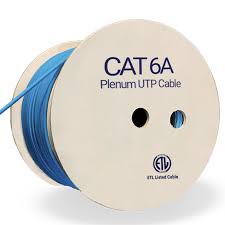Let’s not waste time sugarcoating it—your network is only as strong as the cable it runs on. And if you’re planning for speed, reliability, and long-term performance, Cat6A ETL Listed cable isn’t just a good option—it’s the standard.
Whether you’re wiring an enterprise data center, a modern office building, or even a high-performance home setup, 10-Gigabit Ethernet (10G) is no longer the future. It’s here. And Cat6A ETL Listed cable is the backbone that makes it all possible.
Let’s break down what makes this cable different, why the “ETL Listed” part matters, and why Cat6A is the smart, future-ready choice.
What Exactly is Cat6A?
Cat6A stands for Category 6 Augmented. It was introduced to handle higher bandwidth and longer distances than Cat6. Here’s the short version:
- Bandwidth: Up to 500 MHz (double Cat6)
- Speed: Supports 10G speeds over distances up to 100 meters (328 feet)
- Shielding: Often comes in shielded varieties to reduce interference
- Thicker Gauge: Typically 23 AWG, which improves performance but adds bulk
Compared to Cat5e or even Cat6, Cat6A is built for serious speed and performance.
Why 10G Networks Need More Than Just Any Cable
Running a 10G network on the wrong cable is like putting race fuel in a lawnmower. Sure, it might run, but not well—and not for long.
Cat5e and Cat6 cables can theoretically hit 10G speeds—but only over very short distances (Cat6 maxes out at about 55 meters in noisy environments). That might work in a small room, but it’s a non-starter for most commercial and enterprise environments.
Cat6A delivers full 10G performance over 100 meters. That’s the kind of reliability and reach you need if you’re serious about bandwidth-heavy applications like:
- Cloud computing
- VoIP
- 4K/8K video streaming
- Real-time analytics
- Large-scale data transfers
In other words, all the stuff modern businesses run on.
ETL Listed: Why the Certification Matters
Let’s clear something up: ETL certification isn’t just a fancy label—it’s proof that the cable you’re buying has been independently tested and meets real safety and performance standards.
What Does “ETL Listed” Mean?
ETL (originally from Thomas Edison’s Electrical Testing Labs) is a recognized third-party testing agency. When a cable is ETL Listed:
- It’s tested for fire resistance, build quality, and electrical performance
- It complies with ANSI/TIA-568 standards for networking
- It’s certified for use in commercial and industrial installations
So when you see Cat6A ETL Listed, it means you’re getting a cable that’s been vetted for both performance and safety.
If you’re managing an office, hospital, school, or any regulated environment—chances are you must use ETL (or UL) listed components to pass inspection.
Shielding: Taming Crosstalk and EMI
One of the biggest challenges with 10G networks is noise—specifically alien crosstalk (AXT) and electromagnetic interference (EMI). These can wreck your data speeds and reliability.
Cat6A typically comes with foil shielding, twisted pairs, or F/UTP construction, all of which help isolate signal pathways and minimize interference. Combined with tighter pair twists and better separation, Cat6A cables maintain signal integrity across long distances, even in electrically noisy environments.
Cat6A vs. Cat6: Let’s Put It Head-to-Head
| Feature | Cat6 | Cat6A (ETL Listed) |
|---|---|---|
| Max Speed | 10 Gbps (up to 55m) | 10 Gbps (up to 100m) |
| Bandwidth | 250 MHz | 500 MHz |
| Crosstalk Protection | Moderate | High |
| Shielding Options | Rare | Common |
| Cable Diameter | Thinner | Thicker (23 AWG) |
| Heat Resistance | Lower | Higher (important for PoE) |
| Certification Options | Not always certified | ETL Listed available |
So yeah, Cat6A pulls ahead in every metric that actually matters when you’re aiming for stable 10G performance.
Heat Resistance: The Hidden Advantage for PoE
Power over Ethernet (PoE) is now everywhere—IP cameras, Wi-Fi access points, VoIP phones, even lighting. But here’s what most people forget: Power generates heat. And heat can degrade cable performance, especially in bundles.
Cat6A is built to handle this. It has a larger conductor size and better thermal properties, which means it can maintain performance even when delivering power and data across long distances. Many ETL Listed Cat6A cables are also rated for high-temperature plenum or riser spaces, making them safe for commercial buildings.
Future-Proofing: Spend Now, Save Later
Here’s the truth: Going with Cat6A ETL Listed cable costs more up front than Cat5e or even Cat6. But it’s a smart investment. Why?
Because ripping out cable and re-installing later is far more expensive—especially when you’re dealing with walls, ceilings, or conduit. If you’re already upgrading your network or installing a new one, Cat6A gives you headroom for future tech that hasn’t even hit the market yet.
You don’t want to re-cable in five years when 10G is the bare minimum. With Cat6A, you’re good for a decade or more.
Use Cases Where Cat6A ETL Listed is a No-Brainer
- Data Centers – High-density environments with insane bandwidth requirements.
- Hospitals – Where compliance, safety, and reliability aren’t negotiable.
- Universities & Schools – Digital classrooms need serious infrastructure.
- Smart Buildings – PoE-powered everything means better thermal and data performance.
- Enterprise Offices – Cloud apps, video conferencing, real-time file sharing—it adds up.
If any of that sounds like your world, Cat6A isn’t overkill—it’s what you need.
What to Look For When Buying Cat6A ETL Listed Cable
Don’t just grab the first reel you see online. Look for:
- ETL Markings on the outer jacket
- 23 AWG solid copper conductors
- 500 MHz bandwidth rating
- Plenum (CMP) or Riser (CMR) jacket, depending on your install location
- Shielding (F/UTP or U/FTP) if you’re running near high interference
Pro tip: Make sure the cable comes with a verified test report or spec sheet from the manufacturer. That’s your proof.
Final Thoughts: Why Settle for Less?
In tech, going cheap upfront usually means paying double later. Network cable is no different.
Cat6A ETL Listed cable isn’t just about better performance—it’s about consistency, compliance, and peace of mind. You install it once, and it does its job for years without hiccups. No dropouts. No interference. No sweating over whether it’ll pass inspection.
So if you’re designing a 10G-ready network that can handle the demands of modern bandwidth, you already know the answer. Cat6A ETL Listed is the gold standard—and it’s not going anywhere.





